This gallery contains 1 photo.
My World is a Bight Yellow…
29 Saturday Aug 2020
Posted in Photography, Six Word Saturday
29 Saturday Aug 2020
Posted in Photography, Six Word Saturday
This gallery contains 1 photo.
05 Wednesday Aug 2020
29 Sunday Mar 2020
Posted in Cake, Desseert, Nature, Photography
As does most of the rest of our country, as does most of the rest of the world, we find ourselves confined for the most part to our homes and our yards. If we follow the guidelines we have been given, we can go out for groceries, medicine, gas, and a walk in a local park or our own neighborhood.
It is during this period of “Stay Home, Save Lives” that I am so grateful for the opportunity to go out into the natural world. It is during this moment that I am so grateful to be able to connect with family members on various social media platforms. Nature and family…my two favorite things. And that got me to thinking…
We went to our hometown conservation area the other day to look for spring. Spring is truly breaking out, so we walked and walked. I was on my way through the woods looking for wildflowers, when I turned around to see if Jim was behind me. He was, but I could not see him for a minute or so. And then, suddenly, I knew he was coming…it was his red St Louis Cardinals hat that gave him away (Oh, how I miss baseball!). And that gave me an idea for interacting with my youngest grandchildren. I sent them two pictures, and asked them to find Grandpa. It is so fun to find a way to be close to them, and give them the opportunity to respond in some sort of shared activity.

Where’s Opa? Look for the red hat!
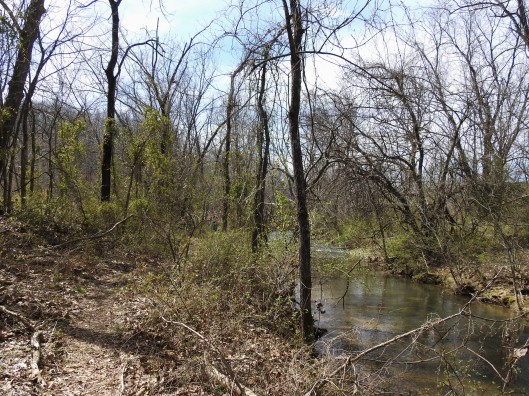
Where’s Grandpa?
Since we are told we can safely go to parks and nature areas, Jim and I do so at least once or twice a week. Other days we walk in our neighborhood, or just visit our own yard. It is so nice to see spring unfolding, and new life returning. I hope you enjoy these pictures of what we have found…not too far from home.
I love encountering wildlife! These Canada Geese are a resident pair at Bray Conservaton Area. They return each and every year to build a nest and raise their goslings to the age when they are ready to strike out on their own. The little orange skipper was a special treat!
Walking in the neighborhood and in the conservation area, we find many wildflowers beginning to appear among the dry leaves of autumn and winter.
But what I love the most on these early spring walkabouts are the lichen and the mosses.
Coming home from one of our walks to a lawn full of violets just makes for a big smile and a better day…
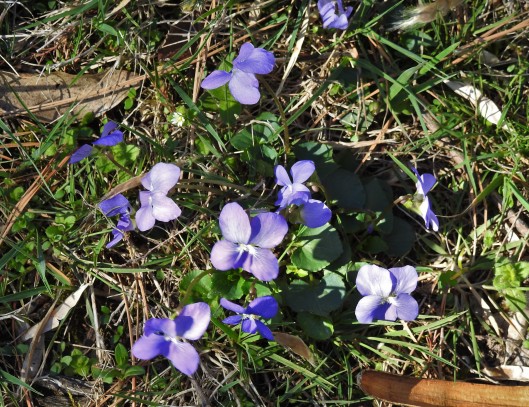
…and then I always feel like cooking, or baking, making some kind of treat to end a great day, no matter what the news is reporting.
Using What I Have
I go shopping once a week during the seniors hour early in the morning. Tomorrow is shopping day, so we are low on a few things…like milk. My daughter-in-law mentioned that she had made a cake with out milk or eggs called Vanilla Depression Cake. That seemed like something I could pull off, and as I looked for the ingredients I would need I found some cocoa way in the back of the cupboard. Chocolate Depression Cake, why yes, thank you very much!
During the Depression years, homemakers tried to make tasty treats for their families even when the cupboard was almost empty. Depression Cake was first developed during this very hard time for our nation. It had to put smiles on otherwise worried and distracted faces, because it is really delicious. I like to think of Depression Cake as proof that you really do not need a lot to show your love, you only need the desire to show that love to those around you…and a bit of creativity.
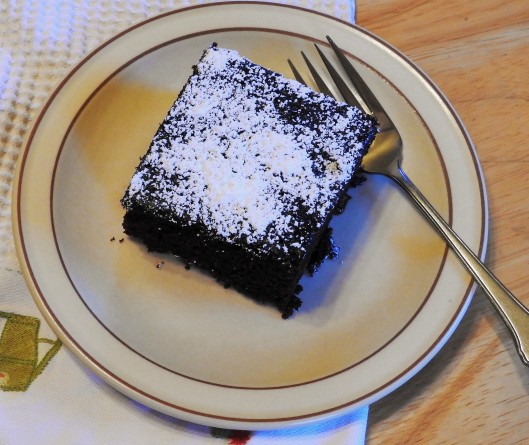
A great way to make a great treat with no eggs and no flour.
Credit: Adapted from Chocolate, Chocolate, and More
Enjoy!
Remember, we are all in this together…God bless and keep each of us!
28 Friday Feb 2020
Posted in Missouri, Nature, Pasta Dishes, Photography, Uncategorized
Unlike the beautiful sunrise just outside my bedroom window, not every day this winter has been full of sunshine and hope. But when this view does appear as I sit with my first cup of coffee and whatever book I am currently reading, hope always encourages me that better things are yet to come…you just have to keep looking for the good, you have to turn off the bad, and you have to strive to do your own part to make this world a better place.
So…we just keep looking, just keep sharing, just keep going. During the Christmas season we visited our son who recently moved from Michigan to Texas. We delighted at the lights in his neighborhood. Nearly every house is lit up for the holidays, a truly memorable, and beautiful experience.
And it was my introduction to mistletoe. The only mistletoe I have ever seen is that which is found in a plastic package at the grocery store. The mistletoe, a parasitic plant that grows at the tops of primarily oak trees was so much more interesting than those packages. Seeing the “kissing ball” in its natural habitat led me to learn more about the plant itself. I love research because I love to learn about new things.
Our youngest grandchildren came from long distances to visit us before Christmas. They, with the help of their very crafty mommas, decorated our windows with snowflakes, and our dining room doorway with a garland.
One of my favorite conversations, a bit bittersweet too, came at the end of January when I went to take the garland down.
Jim: I think you can stop now!
Me: Why, it is almost February, time for hearts and cupids.
Jim: Well, I like that just where it is!
We do miss all our kids who live in five different states, but as I posted on facebook…apparently you can still come to visit our grandchildren’s art gallery on the 4th of July! And that is okay with me too.
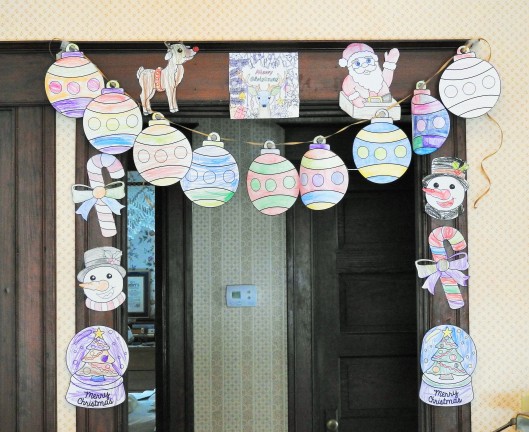
And we went for long walks in nature…
Winter is a marvelous time to look up into the tree tops and down onto the ground beneath your feet. Absent all the green growth of spring and summer, absent all the extraordinary color of autumn, you can see so much that you miss during those seasons. The world is an exciting place, a fantastic experience, and…well, just plain fun and exhilarating!
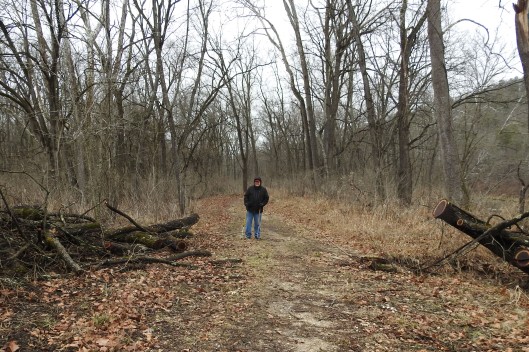
Walks along our rivers, drives through the countryside, hikes in the woods, and visits to the woodland ponds always make for good days…and muddy shoes, even after I try to clean them off!…
Plants are as interesting and beautiful in winter as they are any other time of the year…
But my favorite find of the winter plant season was finally seeing a frost flower. Frost flowers can be seen in early morning after a very cold night. As the liquid inside certain plants freezes, it expands, cracks open the plant stem, oozes out, and makes these beautiful ribbons of ice. This was a really good morning!
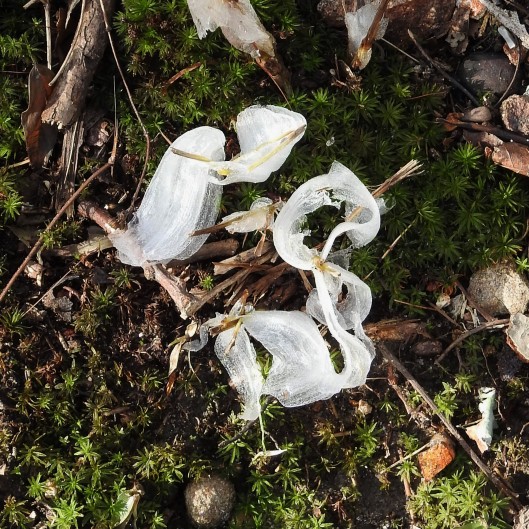
Without leaves on the trees, the birds are easier to see. I love the way the little woodpecker and the northern cardinal are all puffed up to stay warm. The last picture, though not a very good one, is of a yellow-rumped warbler. I had never seen one, so I just had to share it…
And then there was the armadillo who scared me way more than I scared him…
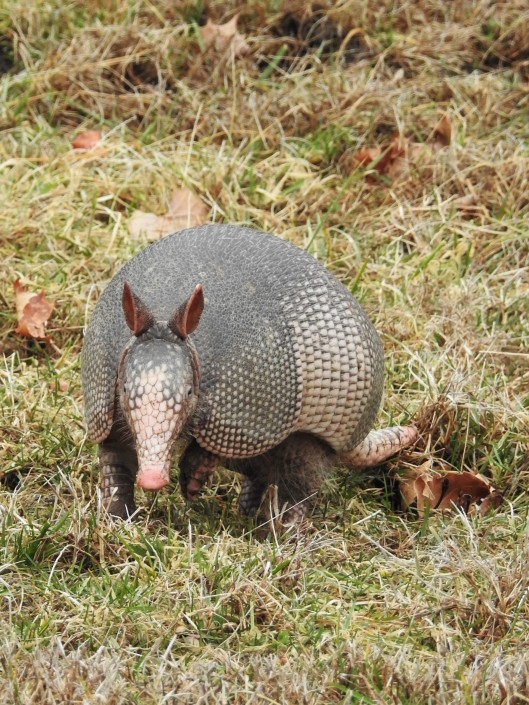
It has been a long, gray, winter, and we found ways to experience every sunny day we had, some cloudy ones too! There have been personal challenges we had not anticipated this winter, I am not very proud of my country right now, and I sure would like the gray to go away.
But…as long as the two of us can roam the countryside together, as long as I can read and learn, as long as I can teach nature classes to young children, as long as I have family, as long as I can enjoy a sunset, there will always be hope for tomorrow. There really is no other choice but hope!
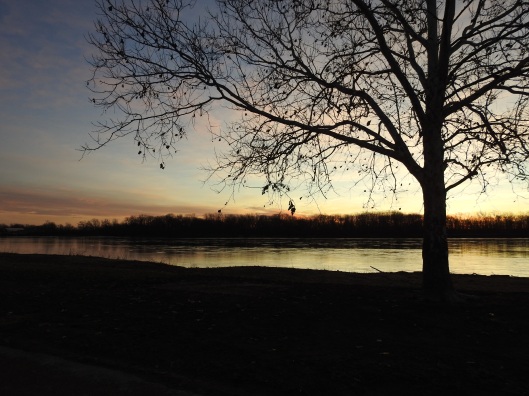
Tortellini and Spinach in Broth
Any time we come in out of the cold, or the gray, I like to fix something simple, warm, and comforting. This tortellini in broth is just that!
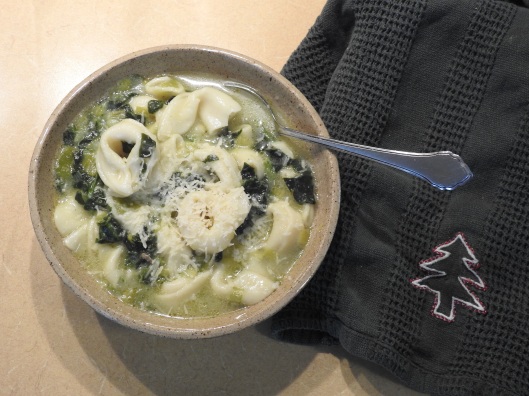
So good on a cold, gray, day! A loaf of crusty bread, lots of creamy butter, and a glass of white wine make this a great evening dinner!Tortellini and Spinach in a Leek Broth
Ingredients
Directions
Enjoy!
26 Tuesday Nov 2019
Posted in Photography, Side Dishes, Travel, Washington D.C.
We recently took a trip to Maryland to visit our grandson…and his parents, too! Our son’s family lives about thirty miles east of Washington DC, so more often that not, we take one day of our stay to visit our nation’s capital. Our primary aim on this visit was the Library of Congress.

The library was established on April 24, 1800, an integral part of the new nation’s move to its new capital city in Washington, DC. At its opening, the library was housed within the Capitol building, and held a total of 740 books and three maps.
In 1814, during the War of 1812, the British burned the Capitol, and with it the Library of Congress, destroying most of its collected 3000 books. To refill the shelves, Congress appropriated the funds to purchase the library of Thomas Jefferson which contained 6,487 books, and represented a large number of topics from many disciplines.
The library suffered another destructive fire in 1851, which destroyed all but 2,000 of the 35,000 books that had been collected following the first fire. Many of the books lost were from Jefferson’s original library.
The Library’s current building opened in 1897. Its architecture draws on the Beaux Arts style, known for its ornamentation and theatrical atmosphere. It was built to last, using marble, granite, iron, bronze and mahogany. It seems that Congress and the architects wanted to do whatever they could to avoid another disastrous fire.

The dome of the new building is plated with 23 karat gold. The plated dome is inside the library’s Main Reading Room, open only to scheduled tours, members of Congress, and government officials.

While we were not able to arrange a tour of the Main Reading Room, we were able to visit the library of Thomas Jefferson.

Our grandson was so excited all day, and could hardly wait until he could see the library of his “favorite” President. As you can see by his picture, he was devastated to find that, for their own protection, all of the books in Jefferson’s library are kept behind glass.

He perked up when he helped his dad find the books that were actually owned by Jefferson. Tabs within the books tell which are his original books, and which are replacements the library has found to replace the many that were lost in the fire. Those that have not been replaced are represented by empty white boxes bearing the name of the missing book.


The Library of Congress is truly a national treasure, as can be seen by the pictures I could not stop taking. I have included but a few in this post…




In 2018, the library reported holding 168,291,624 items, with its more than 90 million books held on a total of 540 miles of bookshelves, making it the largest library in the world. This number is always changing, and these are the latest figures I could find. The items in the library represent more than 450 languages.
Items in the library can be checked out only by Congress, government officials and employees of the library.
My favorite items in the library were the Gutenberg Bible, and the Waldseemüller map of 1507.

This Bible is one of only four remaining original Bibles printed on vellum by Johann Gutenberg, and completed in 1455. The other three remaining copies are located in London, Paris, and in Gutenberg’s native country of Germany.

In 1507, Martin Waldseemüller created this map of the world. It is the first map to depict the New World as a completely separate land mass. Waldseemüller named this new land mass “America”.
After leaving the library we walked to a nearby restaurant and had that all-American dish, pizza! I love eating in Washington, and strolling its streets just as comfortably as I walk the streets in my own hometown. But the best part is to feel how open and free we are, and can be, in this big, wide, wonderful country. We have our problems right now, but as I watched my son read to our grandson on the lawn of the Capitol, then watched as Luke did somersaults in the shadow of its governing bodies, I felt renewed hope that we will find the resolve to come back together and feel the shared pride of being Americans.


On the Top of the Kennedy Center
For our Birthday and Christmas presents, our son and daughter-in-law sent us to the Kennedy Center for the Performing Arts to hear the Washington DC Symphony following dinner at the Roof Terrace Restaurant atop the Center. What a magnificent evening! The acoustics in the hall were amazing, and it was a truly special night.
The dish I had at the restaurant was salmon with Brussels sprouts in a brown butter sauce. It was amazing, so I tried to make a similar side dish at home. My recipe is slightly adapted from one I found on the Challenge Dairy site.

A delicious, easy side dish for all those holiday meals coming your way
Enjoy!
21 Saturday Sep 2019
Posted in Florida, Food, Nature, Photography, Seafood Dishes, Travel
I love being out in nature…climbing to the tops of hills, hiking through the woods, walking along a sandy ocean shore, or even just taking a tour in my own backyard. Recently, while visiting my sister in Florida, I had an opportunity to visit the Hernando de Soto National Memorial near Bradenton. I went planning to take a stroll through the mangroves, but was struck by its historical significance as well.
I just finished reading a book by Jack E. Davis, The Gulf: The Making of an American Sea. It reminded me of the many times I have walked the Gulf coast, and it reminded me of my trip to the mangroves at de Soto. There the history buff in me joined forces with the nature lover to learn what I could about de Soto and nature at the gulf shore.

Hernando de Soto landed on the shore of Tampa Bay at what is now Bradenton, Florida in May of 1539. He came with between nine and eleven ships on which he had loaded somewhere around seven hundred men, two hundred twenty horses, four hundred pigs (yes, that is where all those nasty, nearly uncontrollable, wild boars came from), and about a hundred dogs of war. His purpose for coming to the American continent was for God, glory, and gold.

Scattered through the park are placards of the conquistadors that arrived in Florida with Hernando de Soto in 1539.
At the place where the expedition landed they found a Native American village called Uzita. The men stayed with the natives for a while before moving on in search of riches which would, in turn, bring them power. From Uzita, de Soto and his men would go on to explore areas that are now parts of ten states in the United States, and he would meet many more Native American tribes.


The de Soto site has a recreated Uzita village.
The legacy of Hernando de Soto in North America is not a good one. He had been tasked with making Christians out of the “heathen” natives. But instead, he mistreated the Native Americans he met. In addition to cruel treatment, he had many natives killed, and forced many others into slavery. His expedition also brought disease to a people who had no immunity to illnesses they had never encountered. Thousands died, and later settlers coming to America, such as the Pilgrims and the settlers of Jamestown found nearly empty villages which had once been occupied by proud native people. He never realized the glory he sought because he never found the gold that would bring him favor and influence.
But there is more to Hernando de Soto National Memorial than the sad story of European exploration in the New World. There is the natural side of the memorial, and that was my favorite side…
Walking the trails through the park, you find yourself in a tropical mangrove forest.


Red Mangroves are tropical trees which grow around the world from 25 degrees S to 25 degrees N, though that might change a bit as climate change deepens. They look more like thick impregnable bushes than trees, but can reach a height of 70 feet and a breadth of 20 feet. They have been around for thousands of years, long before any human set foot on the sandy soil of the Florida intertidal zone.
Mangrove forests are habitat for many coastal animals. They serve as nurseries for young fish, and nesting places for the birds of the Florida coast.
As we began to understand the climate change threats to our planet, we also began to understand how very important these wild, unmanageable trees are to the future of our warming world.

The mangrove is an edge plant…it lives at the edge of two habitats. in the ecotone. In Florida, mangroves live at the edge where the land meets the salty sea. They are, in fact, the only tree in the world that can tolerate salt. Mangroves build the coast line, keeping the sand from eternally washing out to sea. There are actually tiny islands out in the Gulf that are nothing more than large clumps of mangrove forest. They can hold back storm surge, and they can break large waves as they crash into shore. You might say they are a natural sea wall!

These thick and tangled mangrove roots hold the coastal soil in place. They are important in alleviating erosion on our rapidly changing coastlines.
But possibly the most important characteristic of a mangrove tree is its ability to capture and store carbon dioxide from the atmosphere. They are ten times more effective in storing carbon dioxide than any other tropical forest plant anywhere in the world. They are important to the future of the planet, yet they have been endangered by the draining of wetlands, and the clearing of land for man-made construction projects.
Efforts have begun in the state of Florida to replant some of the mangroves that have been lost. De Soto park has joined this effort.

Young mangrove sprouts like the ones above are being planted along the shoreline to help reestablish a healthy forest. I saw many newly planted mangrove trees on my visit. The mangrove plant below is full of brown seeds that produce the root spikes that will fall and float in the water until they find a suitable place to settle and take root.

The mangrove forest is full of wonderful sights and sounds, and it is important to future generations who will be working to combat a changing climate in a changing world.
Simple Saturday Shrimp
When I think of the Gulf Coast I think of shrimp, and …
Saturdays around our house are often very busy, but just as often they are lazy days of relaxing, watching sports, and reading. On Saturdays it is hard to get me excited about spending a lot of time in the kitchen! One of our favorite Saturday night dinners is Simple Saturday Shrimp. It is easy, and really requires very little in the way of a recipe.

Place the number of shrimp you will be serving into a baking dish in which the shrimp can lay in a single layer. Make a butter sauce with a quarter cup of melted butter, some minced garlic, salt, pepper, a few red pepper flakes, and the juice of 1/2 a lemon. Pour the sauce over the shrimp and bake at 350 degrees for 12-15 minutes. Serve with some fresh home-made bread for soaking up all that butter sauce…and enjoy!
10 Saturday Aug 2019
Posted in Nature, Photography, Six Word Saturday, Uncategorized

My swamp milkweed are finally blooming…
they are over eight feet tall…
now I anxiously await the monarchs…
but welcome others in the meantime!
My post this week for Six Word Saturday
05 Monday Aug 2019
Posted in Desseert, Laura Ingalls Wilder, Photography
Tags
Most of us have heard the saying, “May you live in interesting times”. Well, the truth is, most every one who has ever lived, no matter how long or short a time, has indeed lived through interesting times. When I was teaching I always tried to make my students aware of how life is chock-full of interesting events not only in their own backyards, but further out into their neighborhoods, their nation, as well as in the big, wide, wonderful world they could hardly even imagine. We hear of some of those events, and many of them go unnoticed.
As I taught history, in the lower elementary grades we call it social studies, I tried always to impress on the students that what we were learning about did not happen in a vacuum. I wanted them to understand how events in one part of the world had impacts on other parts of the world as well. When the printing press was invented in Germany, not only Germans benefited. Rather, the invention of the printing press helped create a whole new world citizenry, one that was better informed, one that was better able to inform.
Laura Ingalls Wilder, author of the “Little House” books was born in 1867 in the “big woods” of Pepin, Wisconsin. She died in 1957 at the age of 90 in Mansfield, Missouri, the town where she had created a home with her husband, Almonzo. Her life was long, and full of so many experiences, some that had dramatic and lasting affect on her life, and some that barely registered at her home in the big woods, or on the prairie, or in the Ozarks of the Missouri.
I recently wrote two posts on Laura for this blog, and as I was looking through the books I have about Wilder, her books, and her life, I came across one, The World of Little House, by Carolyn Strom Collins and Christina Wyss Eriksson, that spoke to the idea of…so, what else was happening while the little house books were happening. The authors present a timeline of events during the life of Laura, and it is indeed amazing to take a look at the events that happened in her one lifetime.
I have tried to put together a collection of some of those events and happenings, and have added some of the pictures I have taken to commemorate them as I have lived my own life, experiencing my own world, its past, and its present as we look into the amazing events yet to come.
When Laura was growing up, her family traveled by wagon…

Picture of a typical wagon that would have traveled across the Kansas prairie.
But Laura was alive when Henry Ford introduced the first American automobile, the Model T, and by the end of her life she would have seen the “car” change in so many ways…
There are many inventions that debuted during Laura’s life, inventions that we cannot even think of living without…
The first telephone appeared in 1876, first phonograph in 1877. Doctors were better able to diagnose injuries with the invention of the X-ray in 1896, and Jonas Salk introduced the first vaccine to guard against polio in 1954. Don Juan, the first talkie movie debuted in 1925, and Jim Henson created the first Muppet, Kermit the Frog, in 1955. The first ice cream soda appeared in 1874, and one of my favorites, Coke (served in the original 7 oz. bottle), was first served in 1886. And Orville and Wilbur Wright flew the first plane at Kitty Hawk in 1903, changing travel, already made more accessible by the Transcontinental Railroad in 1869 and the automobile earlier, forever. Laura was alive in 1932 when Amelia Earhart made her famous solo flight across the Atlantic in 1934.
Laura also saw the first Montgomery Ward catalog house built in 1871, along with the first performance of the Barnum and Bailey Circus in that same year. The Burpee Co. sent out its first seed catalog in 1878, and we know from her writings that Laura loved looking through them each year as she planned her garden. The first American zoo opened in Philadelphia in 1874.
Laura saw the territory where her parents lived out their lives, South Dakota, gain statehood in 1889. She was living in South Dakota when, in 1884, oil was discovered in Independence, Kansas, not far from where she had spent some of her childhood. Indeed, twenty-three wells would eventually surround the area of the little house on the prairie.
The little house books present a picture of Native Americans that is not to be lauded. Most settlers were afraid of the Native Americans and events involving these natives did not encourage them to change their minds. This was a nation, a population, in the midst of peopling a continent, of bettering their own lives by, they believed, bettering the land. Their purposes, their industriousness, their land hunger did not bode well for the people who had been here for centuries before their arrival.
In 1868, the Osage signed a treaty selling their Kansas lands to settlers for $1.25 an acre. In 1870, Congress forced the Osage to abandon all their land in the territory. Laura was only a toddler when these events took place, but they would play a major role in the life of her family as they moved around the new American heartland.

The Osage are considered the indigenous tribe of my own state of Missouri. Just outside Cuba, Missouri, a memorial has been erected to honor these people who had come before. As they lived and moved around the area, they made trails, their own “highways”. Eventually those paths were paved over and became the concrete highways of mid-America. Where this memorial stands, US 66 became one of the most fabled highways in America. Just next to the memorial is Interstate 44 which replaced a large portion of the iconic Route 66.
One wonders what went through the Ingalls’s minds as they learned of the Battle of Little Bighorn and the fate there of General Custer and his Seventh Cavalry in 1876. Or what might Laura have thought when news of the Battle of Wounded Knee reached her in 1890.
Laura lived through the Administrations of seventeen presidents, from Andrew Johnson to Dwight Eisenhower. She lived through the era of Prohibition beginning in 1919, and she and Almonzo suffered from the effects of the Stock Market crash in 1929. She would have joined other women of the day in rejoicing at the passage of the 19th Amendment giving voting rights to women in 1920.
In 1885, when Laura was 18 years old, the Washington Monument was dedicated. Just a year later, she would have celebrated along with the rest of the country when the Statue of Liberty found its home in New York Harbor. She witnessed the building of the Empire State Building in 1931, at the time the tallest building in the world.

A bucket list item…the Washington Monument seen among the cherry blossoms that bloom each spring in Washington, DC.
Laura lived through four wars, the Spanish American War, World Wars I and II, and the Korean War. She would have felt the same shock as all Americans when an American naval base at Pearl Harbor in Hawaii was attacked by the Japanese, bringing the United States into the Second World War, and she would have wept with all the world when the war ended with the American bombing of Hiroshima in Japan. She would have found hope, as did all the world, at the founding of the United Nations in 1945, dedicating itself to the promise of finding peaceful solutions to world problems and aggression.
And last, but not to be left out, some of the books that were published during Laura’s lifetime, many of which are my favorites. The years between 1867 and 1957 saw the publication of such great books as Little Women, the Wizard of Oz, Huckleberry Finn, Anne of Green Gables, Gone with the Wind, The Great Gatsby, Grapes of Wrath, Charlotte’s Web, The Death of a Salesman, and two that every child today knows and loves, The Cat in the Hat, and The Grinch Who Stole Christmas.
What a full life was Laura’s. What an exciting time to be alive, as a nation moved out, matured, and took its place in the wider world. What lessons to be learned from a nation’s inevitable growing pains.
May we all live in interesting times!
Laura’s Gingerbread Cake

One of Laura’s favorite recipes was for Gingerbread Cake. Here it is as I found it at the Epicurious website. I made it just as it was written. Laura often liked to serve this really delicious gingerbread with chocolate frosting. Jim and I love gingerbread with whipped cream, so that is how we enjoyed Laura’s Gingerbread.
Enjoy!
08 Monday Jul 2019
Posted in Chicken, Laura Ingalls Wilder, Missouri, Photography, Travel
Tags
Every American child has heard of, read from, or watched the television series based on, the Little House books written by Laura Ingalls Wilder. They chronicle the life of a young girl growing up in an America that was reaching ever outward, and ever westward. Laura’s family was part of that pioneer settling of a young and expanding nation, and in so doing experienced the joys and the inevitable hardships felt when seeking life and opportunity in lands previously unknown, often misunderstood, and always demanding.
Charles and Caroline Ingalls moved five times from homestead to homestead with Laura and her sisters, ever looking for that one spot to put down roots for good. Laura’s books tell of the challenges of those years, but they also tell of a young girl who loved the land and grew attached to it in many of the same ways her Pa had done. The books speak of the simple pleasures of living in the vast unknown as well as the hard times that came and went over the years. The books also speak to the love and closeness of family.
Pa and Ma finally found that place to put down permanent roots…Ma finally put her foot down…in the town of De Smet, Dakota Territory (South Dakota now). Laura and her husband, Almonzo, lived on their own homestead near her parents. But they eventually suffered many of the same hardships as had plagued Charles as he sought out his place to call home. In July of 1894, the young Wilders with their daughter, Rose, packed up their belongings and moved…south and east…to the Ozarks of Missouri.
The Laura Ingalls Wilder Historic Home in Mansfield, Missouri, about an hour and forty-five minutes from where we live, has become a popular tourist destination for those who love Laura and her books. We have been there several times, but on this visit a few weeks ago, we went with newer questions, and a different purpose for what it was we wanted to see. After reading, The World of Laura Ingalls Wilder, the Frontier Landscapes that Inspired the Little House Books, by Marta McDowell, this trip was to be about the land, the property, the Ozarks and its draw to a young couple seeking “home”.

The house that Almonzo and Laura built in Mansfield, Missouri. Over the years Almonzo added rooms as they were needed, and as the couple was able. A close inspection of the chimney will uncover fossils that were deliberately included when it was built.
Mansfield is located in the Ozark Mountains, and sits on the Salem Plateau. While the Ozarks are not the highest or most grandiose of mountains, they are very hilly, and they are very rocky. Farming them was a challenge, and a lot of hard work. For Almonzo and Laura, it was a new start, in a new place, with what they believed to be endless opportunities. They named their new home, Rocky Ridge Farm.

This ravine is just a short distance from the Wilder house. It is a perfect example of the rocky and wooded terrain the Wilders found when they reached Mansfield.

This is the view out Laura’s kitchen window…I wish mine was the same!


Laura kept a chicken house, which is still on the property and still houses chickens.
Almonzo found apple trees on the property when they arrived, added many more, and the Ben Davis apple became their primary crop. They also planted row crops such as corn. The land was rich in oak, hickory and black walnut trees. Black walnuts remain a major product out of the Ozark region, a taste so much deeper and stronger than the well-known English walnut.
Laura and Almonzo were very happy on their Ozark farm, and remained there for the remainder of their lives. They worked hard on the land, producing much of what they needed as a family. They were also active in their community.
Here in Missouri we celebrate Rocky Ridge Farm as the place where Laura wrote all of the Little House books. She also authored many articles for various newspapers and magazines about her life at Rocky Ridge, as well as practical articles about living life successfully on a farm.
When Rose grew up, and began her own successful career as a writer, she returned to Rocky Ridge to build her parents a “modern” house, with modern conveniences based on a floor plan from Sears Roebuck & Co. Yes, Sears once sold plans for, and kits for actual houses! The house was called the Rock House. Laura and Almonzo lived in the house for some years, but after Rose moved away permanently, they returned to the original house, where they felt most at “home”.

Rock House, the house that Rose had built for her parents in their later years.
You are not allowed to take pictures inside either of the houses when you take the tour, so our main objective was to tour the houses, and then to walk the lands that Laura walked in Missouri. We wanted to imagine her life as she settled into her new home with new responsibilities and new challenges. We wanted to explore this Missouri homestead so loved by Laura and Almonzo, just as we love our own Missouri homeplace. But, on that day…

if you know anything about the weather of the American Midwest, you know that big, complicated storms can arise at almost any time, especially in the heat and humidity of a typical Missouri summer.
We had wanted to walk the three-quarter mile path between the two houses. Seeing this storm quickly approaching, and feeling the heavy winds that began to develop, we knew it was no time for a walk, and definitely time to seek the safety of the car and our drive home. What we did not know was that we would be driving into a tremendous storm known as a derecho. A derecho is a storm that is the result of several severe thunder storms which gather together to create a storm that stays together long enough to cover many, many miles. It is characterized by strong straight line winds, many of which can reach hurricane force, heavy rains, and tremendous lightning The rain poured, the thunder crashed, the lightning was the most impressive I had ever seen, and the winds and my steering wheel fought for many miles. My white knuckles should have informed us that being on the road, in the car, was not our best option! But we made it home…and it was actually kind of exciting…after the fact!
I was determined to walk that path between the houses, so the very next week, we went back. I was so glad we did! We left very early in the morning because Missouri is too hot in the summer for an afternoon walk. The air was rather still, and fog and haze was with us most of the morning, which only made the walk more beautiful. One can only imagine Laura and Rose walking the path back and forth to visit one another. Here is what we found on our walk in 2019…

Mornings do not get much better than this one on which we found ourselves out and about early in the morning.





For many people who traveled across the plains, the prairies, and the hill country of Missouri, one tree would often be the only tree they would see for miles and miles. I thought of that when I saw this tree in the middle of the fields by which we walked.

I loved coming back down the path to see the break between the woods and the fields!
And then there was the flora and the fauna…
But what I like best was a walk along a path that was traveled so many years ago by people who loved this area of the country as much as Jim and I have come to love it…
If you visit Laura and Almonzo’s home in Mansfield, you will begin your visit at the Visitor Center which has a very nice museum about Laura’s life on the prairie, in the big woods, and in Missouri.

After your visit, you are bound to be hungry. There is a little shop in Mansfield that sells the best fresh lemonade, a great hamburger that tastes like I made it at home, and ice cream cones that taste great even while driving through a thunderstorm.
If you find yourself in Missouri, I hope you have a chance to visit Mansfield, and that you take the time to take a walk back in time…a walk not so different from our Missouri walks today.
Midwestern Farm Food

This is a hearty meal to come home to after a hard day of work on the farm…or any day of hard work. I found this recipe in a book I purchased many years ago, The Little House Cookbook: Frontier Foods from Laura Ingalls Wilder’s Classic Stories, by Barbara M. Walker. I adapted it a bit, primarily using my mom’s flaky crust for the topping. It reminded me of the big dinners she would make for us after we had gone out into the countryside to pick fresh fruits and vegetables to can in our city home. When I make this again, and I will, I will omit the hard-boiled eggs which did not really add to the dish.”
This is a really good chicken dish. The chicken simply falls off the bone. Add a salad from the garden, and you will have a great meal, certain to satisfy any hungry person at your dinner table.
Enjoy!
09 Sunday Jun 2019
Posted in Art, Beef Dishes, Food, Illinois, Nature, Photography, Uncategorized
Tags
Several months ago I saw a notice on a Facebook page I follow of trolls at Morton Arboretum in Lisle, Illinois, not too far outside of Chicago. It was accompanied with a picture of one of the trolls..and I knew I had to go, I had to meet these trolls!
So we packed our bags and got on the highway toward Illinois…not as easy as it might sound with all the flooding along the river that divides Missouri from Illinois, that mighty and surging Mississippi.
I always tease about the flatness of the terrain in Illinois, but there is something comforting about driving through the comfortable Midwest of this great country we call home…
An arboretum is defined as an “outdoor museum of trees”. Morton Arboretum, dedicated to the conservation and study of trees, was established in 1922 by Joy Morton, founder of the Morton Salt Company. He was from a family that loved the outdoors and especially trees. His father, J. Sterling Morton, was the force behind the creation of Arbor Day, and the family motto was “Plant Trees”.

The acorn statue, several of which are found Arbor Court, symbolize the mission of the Arboretum, the study and conservation of trees. The White Oak is the state tree of Illinois.

We had come to see the trolls, but first, as we walked around the lake, we saw the Lego creations on display at the Arboretum. They were amazing and were placed at intervals surrounding the lake.
And then it was time to go looking for trolls. The trolls are the creation of Thomas Dambo, a Danish artists who uses reclaimed wood to build amazing pieces of art. He has created six trolls for Morton Arboretum, his first large exhibit in the United States.
The trolls at the Arboretum are angry with humans who are more interested in getting rich than caring for the environment. They have come to tell us we need to stop destroying nature…or else! They are truly wonderful, and the most amazing thing about them is how very detailed they are. They are between fifteen and thirty feet tall, with one that is lying on the ground, ready to eat any human that comes along, measuring an amazing sixty feet.
We found all the trolls, and enjoyed walking and driving through the property while we “searched”.
My favorite troll was Niels Bragger. He is a big bragger and carries an even bigger club! Niels is found deep in a wood, and walking the 200 feet into his hiding place took us by large trees and beautiful woodland flowers. My favorite were the wild geraniums which were the biggest I had ever seen.
As we drove into Lisle, we saw our first troll high above the highway at the edge of the Arboretum. He is called Joe the Guardian, and he will be guarding all the trees at Morton throughout his stay until the end of the year. I climbed up to visit Joe, a muddy trip after all our rain…and I will not be wearing the snowy white tennis shoes I wore that day ever again!


The largest troll is Little Arturs, who at sixty feet is anything but little! His mouth is wide open, so keep your distance!

We saw Sneaky Socks Alexa, whose job it is to try and catch the little humans who are causing pollution and destroying nature’s trees.


Furry Ema has a trap also, just waiting for anyone who bears ill will toward the tree under which he is sitting.

And then there is Rocky Bardur who does not like the pollution caused by cars, and is really unhappy about the parking lot built at the Arboretum, a sanctuary for nature. I was personally happy to find a nice place to park our car, but I get his point.
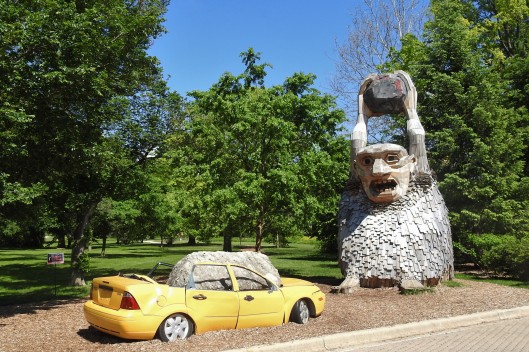
But there was more to this day than Legos and trolls. Morton Arboretum is a beautiful place with my favorite habitat, woodland. I took full advantage of walking many of the trails, breathing the woodland air, and enjoying the sights and the sounds of the woods. Enjoying a walk in the woods with my husband of almost fifty-one years, being in nature, seeking fantastic trolls…I just feel better. And I just leave the real world behind for a bit!
Thomas Dambo’s trolls will be on exhibit at the Arboretum through the end of the year, and is well worth an adventure into America’s Heartland.
I looked into the significance of each troll, and learned more about the artist at Thomas Dambo’s website.
Maid-Rite Hamburger Sandwiches
When I was a little girl, my mom used to fry hamburger with onions, a bit of salt and a dash of pepper. We would take slices of Wonder bread, put some of the loose hamburger on one half of the bread, then fold it over to make a sandwich. They were simple to make, they were cheap to make, and they made a perfect dinner for our family of six. Mom usually added a serving of corn or green beans that she and my grandparents had canned in the summer, and life was good.

Maid-Rite is a hamburger sandwich restaurant chain in the Midwest that makes a very similar sandwich and is very popular. It was founded by Fred Angell in Muscatine, Iowa, who opened his first Maid-Rite restaurant in 1926. It is one of Illinois’ iconic foods. There are as many variations as there are restaurants, but here is the way I like them…if I don’t just use my mom’s very simple version.